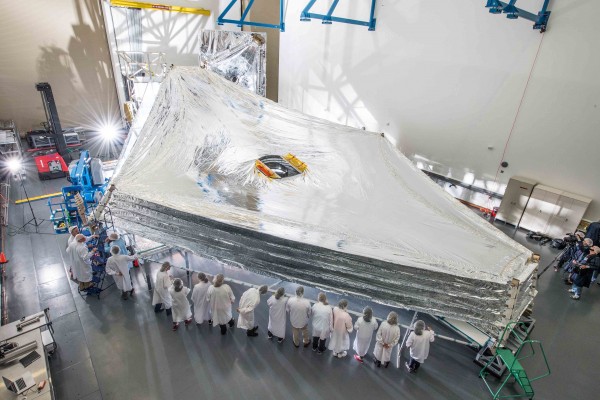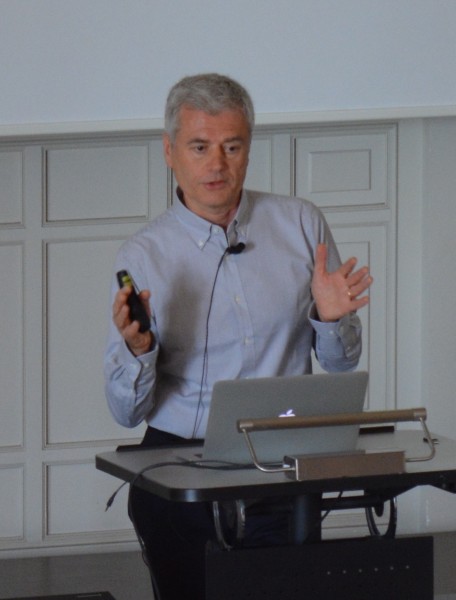“James Webb is a challenging mission”

Observing exoplanet transits will be one of the big science areas of the James Webb Space Telescope (JWST), says Mark Clampin, Observatory Project Scientist of the JWST at NASA’s Goddard Space Fight Center. He was one of the speakers at a conference in July in Bern where 185 participants from all over the world discussed about “Pathways towards habitable planets”. The JWST with its 6.5 meter mirror is the successor to the Hubble Space Telescope.

The sunshield on the James Webb Space Telescope is the largest part of the observatory (Photo: NASA/Chris Gunn)
PlanetS: What is the status of the JWST?
Dr. Mark Clampin: Right now, the telescope is being assembled. It has reached what NASA calls “the integration and test phase”. So we have finished building most of the components. The instruments will enter the last cryo-test later this year and our main contractor Northrop Grumman has just finished the telescope structure. So that is sitting in a cleanroom at Northrop Grumman and will be shipped to the Goddard Space Flight Center soon.
Early next year we will put the instruments into the telescope. That will be done in Goddard. Then the telescope structure will be shipped to Texas where they have one of the world’s largest test chamber for cryogenic testing at a temperature of 40 Kelvin. There we will test all the optical systems. The basic idea is to make sure that we don’t make a similar mistake that we have done with the Hubble Space Telescope.
Will the telescope be ready for launch in 2018 as planned?
Right now it is on schedule. We have underwent a re-plan activity in 2010 and we have been on schedule ever since.
How much does the JWST cost?
The life cycle cost is 8 billion dollars. James Webb is a very challenging mission because it’s cryogenic and it has multiple deployments. We have been testing the deployment of the five sunshield layers just a few weeks ago. We are doing lots of tests to make sure that everything deploys correctly.
What do you think of CHEOPS, the small ESA mission led by Switzerland that costs about 100 million Euros?
I think it is a very interesting, a very nice mission. I went to one of their meetings last year. There is a lot of synergy between JWST and CHEOPS. Certainly we are watching what CHEOPS does because it will feed into some of the early targets we will look at with the JWST.
How will exoplanetary research profit from the JWST?
In the field of exoplanets JWST can do two things: We can do imaging. Two instruments have coronagraphs. So we can basically do high contrast imaging from wavelengths of 0.7 microns to around 20 microns. Most of the objects that we will study with JWST will probably be very young systems with young gas giant planets. But JWST is also capable studying M-star systems. M-stars are a lot fainter than solar type stars. Therefore you have a problem with the background when you are on the ground. But JWST should be ideal to detect planets around M-stars. So that’s the imaging part.
Besides the imaging, I think the part that people get excited about is the ability to do transits. JWST was designed around 1998 – before people did many transit observations. However we have been able to modify a number of instruments to fine tune them to be able to do a lot of nice, very high precision transit spectroscopy. There are a lot of capabilities. We try to make the transit observations as easy as we can. That will be one of the big science areas of the JWST.
Do you expect to detect the atmosphere of an Earth-like planet?
This is a matter of debate in the community. I think that JWST will do a really great job doing comparative planetology. Studying gas giants and Neptunes will be very straightforward. However, we will want to push to understand Mini-Neptunes and Super-Earths. I think we can definitively do Super-Earths, but getting down to true Earth-like planets is going to be tough. Firstly, we probably only observe M-star candidates.
There is a lot of debate at this meeting whether planets of M-stars have no water or too much water for life. That was one of the most interesting topics at the Pathways 2015 conference: the potential habitability of planets around M-stars, whether you end up with these planets being either solid desert planets or waterworlds.
Compared to ground based and other space telescopes, will the JWST be the best instrument for quite a long time?
I think it will. My sense is that it is still extremely hard to do good transit observations from the ground. And I think it is going to stay that way for a long time. So there are probably some things that you want to do always in space. From the ground, you may get to the point where you do some of the easier observations.
What other scientific questions will be studied with the JWST?
The big objective with the JWST is the First Light. People want to try to push back to the first generation of galaxies. But it is not clear how soon that will be done after launch. One of the things we have learned from the Hubble Space Telescope and the Hubble deep field is that this is a very demanding observation. You need some time to understand how your instrument works before you start to do the very large challenging programmes. So I’d be surprised if we did a deep field with JWST straight away.
How much telescope time will be spent for exoplanetary research?
At the end of the day, JWST will be run at the same way as the Hubble Space Telescope. There will be a call for proposals every year and there will be a telescope allocation committee that needs to review the proposals. So it really comes down at how well coordinated the exoplanet community will be in writing competitive, large proposals. That decides how much time they get.
What are you doing when the James Webb Space Telescope is finished?
In addition of working on JWST, I am also involved in Goddard thinking about the next big mission afterwards. There are a number of different ideas. Recently, AURA (the Association of Universities for Research in Astronomy) released a report about a future space telescope. We at Goddard are thinking about a 9 to 12 meter segmented telescope in the visible wavelength range. We would do a survey of 600 to 700 stars followed up by doing the spectroscopy to search for biosignatures in the atmospheres of the candidate earth-like planets.
You want to go back to the visible, why?
If you want a telescope that big at low cost, doing a cryogenic telescope is not the way to do it. We had to do JWST as a cryogenic telescope because it’s science objectives involved working in the near infrared. If you don’t need to work in the IR, then don’t. It takes a lot longer to build the optics and it’s much harder to test them. We are also thinking about telescopes that can be serviced. The JWST is not serviceable because, to get to the right temperature, you have to wrap everything in so many different layers of blankets and shrouds that you just can’t pull an instrument out.


